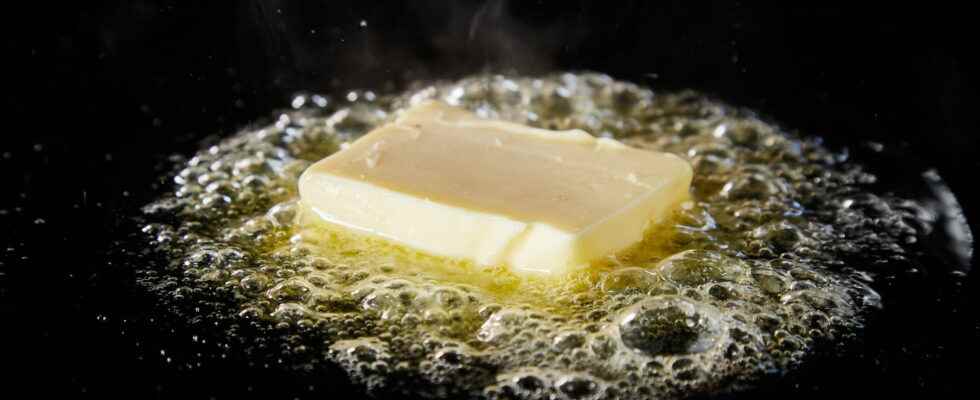For the Director General of the WHO “trans fatty acids kill and should not be found in food”. In what foods are they found? Margarine, cooking oils? Nutrition list and advice to preserve your health.
[Mise à jour le 24 janvier 2023 à 16h46] The trans fatty acids are part of the so-called “fats”fatty acids” (AGI). Trans fatty acids can be natural or industrial (pre-packaged foods, baked goods, cooking oils, margarine and spreads).”5 billions of people around the world are still not protected against trans fatty acids, harmful substances that increase the risk of heart disease and death“ alerted theWHO in a report dated January 23, 2023 before estimating that it “it’s time to get rid of it once and for all”. “Every year in the world, the consumption of trans fatty acids is responsible for no less than 500,000 premature deaths from coronary heart disease.“.
Definition: what is a trans fatty acid?
Trans fatty acids form a category of acids unsaturated fat (AGI), whose carbonic double bond is in the “trans” configuration. In other words, the hydrogen atoms are not on the same side of the molecule. This configuration exists in nature but it is more often the result of a industrial process to increase the life expectancy and texture of vegetable oils (synthetic trans fatty acids). “This industrial process is often hydrogenation which allows change from liquid fat to solid fat. These unsaturated fatty acids, which had beneficial effects on health, lost these beneficial effects due to the loss of this double bond., says Laurence Plumey, nutritionist. Trans fatty acids are present in many food industry preparations : ready meals, sweets, breakfast cereals, etc In small quantities, they are not dangerous for the organism. In too large quantities, however, they increase the risk of cardiovascular illnesses.
What are natural trans fatty acids?
“Some trans fatty acids are said to be natural. They are produced in the stomach of ruminants (cows, sheep) by the bacteria residing there. These fatty acids are then incorporated into the body fats of animals and in their milk. They are therefore present in the meat, milk and dairy products“, explains the website of the National Health Security Agency (handles). “These trans fatty acids are absolutely harmless because they do not have the same molecular formula as trans fatty acids from an industrial process”, comments Laurence Plumey.
What are industrial trans fatty acids?
“Trans fatty acids of technological origin are used in the food industry as stabilizers and preservatives. They make foods firmer and more stable, thus less prone to rancidity.” specifies the ANSES website. There is no no labeling rules for trans fatty acids. However, some manufacturers may specify on their packaging the term “partially hydrogenated oils or fats“, an indicator of the presence of trans fatty acid.
Which trans fatty acids are caused by cooking?
Trans fatty acids can also form during cooking high temperature vegetable oils, adds the ANSES website. However, according to our expert, “these are processes specific to industrialists, very sophisticated, and whichwe do not find when cooking fat at home.”
What foods contain trans fatty acids?
Trans fatty acids are found in processed industrial products as :
- pastries
- the biscuits
- margarine
- pizzas, nuggets, industrial fries…
- the candies
- the quiches
- certain cooked meals
“You should not exceed between 5 and 10 grams of trans fatty acids per day”
As for the natural trans fatty acids, they are found in:
- ruminant meat
- Milk
- milk derivatives (cream, butter, cheese…)
How much trans fatty acids to consume per day?
“We shouldn’t not exceed between 5 and 10 grams of trans fatty acids per day and the average in the population is currently less than 5 grams”, assures our expert. Thus, ANSES restarts a maximum threshold for trans fatty acids at 2% of the total daily energy intake, regardless of age, gender, both in children and adults.
Are trans fatty acids good for your health?
“Trans fatty acids have no known benefit” said the Director-General of WHO, the Dr Tedros Adhanom Ghebreyesus on January 23, 2023.”There are no recommendations regarding the consumption of trans fatty acids, the body does not need it“, confirms the nutritionist.
What are the dangers of trans fatty acids on health?
“Trans fatty acids are a toxic, killing chemical that shouldn’t be in food” insisted the Dr Tedros Adhanom Ghebreyesus. “It is considered that the excess of trans fatty acids would have adverse health effects. It would increase the risk of cardiovascular disease if they were chronically consumed in excessive quantities” continues Dr. Plumey. Excessive consumption of trans fatty acids increases the LDL-cholesterol level (bad cholesterol) and lower HDL-cholesterol (good cholesterol) in the blood. For our expert, practices for using these fats have evolved in the right direction in comparison. “We currently find much less That Ten Years Ago (2010) because manufacturers have made great progress and hardly use these hydrogenation processes anymore. There are hardly any trans fatty acids in margarines and very little in cookies, cakes and pastries which were the main sources”assures Laurence Plumey.
Thank you to Dr Laurence Plumey, nutritionist, author of numerous books including “Le Grand Livre de l’Alimentation” published by Eyrolles – and founder of the EPM Nutrition School.
Source: “Five billion people are unprotected from trans fatty acids that cause heart disease.” WHO press release, 23 January 2023.
